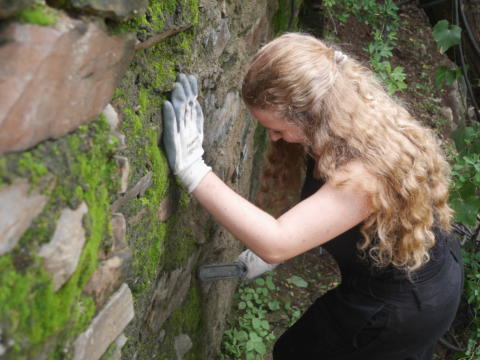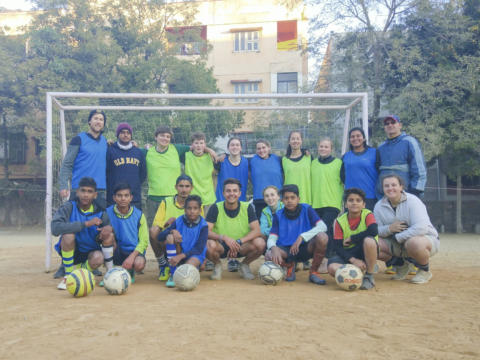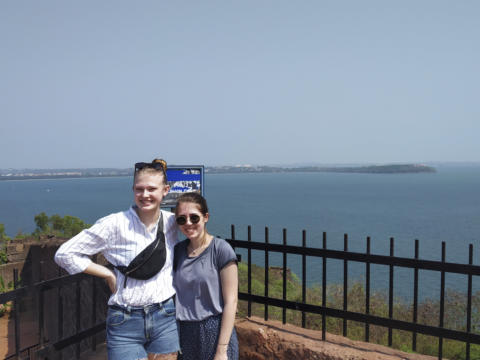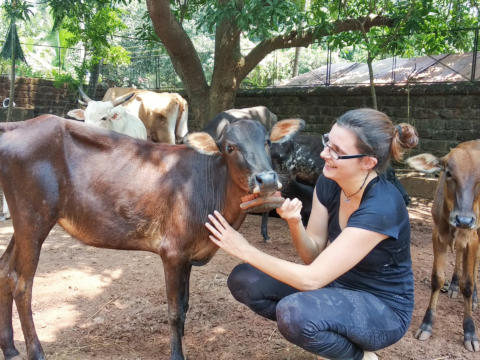Only 780€ per week!
India Explorer
Southwest by Northeast - India
Visit beaches, experience culture, go hiking, walk through temples and renovate Himalayan Buddhist monasteries. Take back the best experience that India has to offer in 21 days of travel!!
You will travel across the beaches of the west coast to an ancient kingdom, walk into Palaces of Maharajas, row your way in the coconut fringed backwaters, hike into tea plantations, immerse yourself into ancient temples and give back in the abode of the Himalayas.
Program Description
This is an Eco – travel project that lets you visit 5 different Indian states in a month. Letting you experience everything from its amazing culture to its sublime cuisine by traveling through a cross-section of this vast sub-continent. Keeping with the values of our organization, this program is environment-friendly.
This travel tour starts from Goa which boasts of pristine beaches and Indo-Portuguese culture and into the ancient temple kingdom of Hampi to marvel at its stone architecture and ancient cultures. From here we go down South to the backwaters of Kerala and hike in the tea plantations of the blue mountains as they are called. Travel to the Southwestern part, to the city of Madurai in the state of Tamil Nadu, to visit magnificent ancient Hindu Temples and also witness ancient forms of dancing. Your tour then takes you to the north of India to the foothills of the Himalayas in Sikkim where you can help the local Himalayan communities by teaching at local schools and in renovating Buddhist Monasteries.
You will have the most memorable experience visiting local markets, tasting various Indian cuisine, temple visits, nature experiences and taking part in community service in many ways will be the norm for these 21 days.
The program also focuses on a variety of community engagement projects. You will have the opportunity to work alongside local people at our renovation projects at our community schools and also take part in environmental initiatives.
We encourage our participants to take the initiative to build, renovate and beautify Buddhist monasteries or public schools as most of the schools in India and community centers are not very attractive, do not have the learning atmosphere and excellent infrastructure for children. We are working to make such type of centers attractive with children friendly aspects.
Activities
- Cleaning and dusting the walls, ceiling, scraping off the old paint
- Apply base color, once or twice as per requirement
- Plan out the required drawings as per the requirement of the class
- Draw and paint animals, alphabets, colors, fruits, vegetables, body parts, tables, rainbow, shapes etc
- Gardening (eg. teaching children to grow a vegetable garden)
- Cleaning the classrooms
- Handover the beautified classrooms to children/community
- Carpentry, fixing doors, windows or any wooden installations
- Setup rainwater harvesting systems at remote villages
- Build basic toilets for underprivileged communities in remote rural villages
- Building play structures for children
- Constructing tanks for easy access to clean drinking water at the slums
- Construction of clean and hygienic toilets
- Construction of cooking stoves as the slums
- Setting up solar panels at the slums as per-requirements
What’s included
- Airport transfers as per the policy – Airport Pickup in Goa
- Presence of a dedicated program coordinator throughout your travel, at the projects and facilities- Logistical management support in case of emergencies
- Authentic Indian meals and European for the duration of the entire program as per the meal plan – Breakfast, Lunch and Dinner
- Accommodation at hotels, homestays, and at our accommodation facility – Shared accommodation.
- Local transportation to all venues
- Entry fees to all places
- Extensive pre-departure information
What’s Excluded
- Personal expenses such as table drinks, room service items, laundry, telephone calls, tips, portage at hotels or airport, bottles of water during your road travel etc.
- Any additional expenses caused by or liability for the disturbance in the trip program due to circumstances, weather conditions, sickness, natural disasters, riots etc.
- Liability for or insurance against injury, loss of life, accidents or loss of goods
- Our program does not cover any liability and does not insure participants. Participants must have appropriate insurance before joining the program.
- Any camera fee where applicable.
- Visa application.
- Any service not specified above
A few things to consider while you are with us
- The participants are requested to be back at the center or guest houses by 22:30 every day
- Participants will not be entertained to hire any vehicles on their own
- Consumption of alcohol is strictly prohibited at all our Centers
- Respect and adhere to our code of conduct
- Our staff is there to support you and to guide you and make your trip memorable, we request you to kindly follow their instructions at all times.
- You will not be allowed to bring outsiders to our centers, guest houses or hotels
- Please provide your mobile phone number during the time of booking, as this will be useful for us to contact you at the Goa Airport as this is quite a crowded airport, and we would not want to lose you!
Aims & Objectives
The aim of this program is to bring you closer to authentic India from the south to the north. Through different projects and activities, you will get to truly immerse yourself in the diverse culture, ancient architecture, different customs and lifestyle.
Schedule
Week 1
Day 1: Monday
After your arrival at Dabolim Airport in Goa on Sunday, our coordinators will receive you at the airport and transfer you to our base in North Goa which is about a 45-minute drive.
You will be introduced to your fellow travelers and other participants working on various social projects. Begin with an orientation session which will take you through Indian culture, do’s and don’ts as a traveler in India, and safety precautions during your travel. We then go out to visit the famous colorful Goan market and visit the North Goan beach to watch the sun go down the Arabian sea.
Day 2: Tuesday
We begin our day with a visit to Old Goa, the part which was previously a Portuguese colony. Admire the beautiful Portuguese architecture and visit the beautiful spice plantation hidden away in the mountains and enjoy some great spread of Indian food in the pristine location. Later in the evening, we will go for a Bollywood movie.
Day 3: Wednesday
You will learn cooking Goan food and visit the beach for a few hours.
Day 4: Thursday
In the morning we will give you a Hindi language class, teaching you a few words which will be helpful for you through your travel in India, in the afternoon after lunch you will go and visit Fort Aguada before taking an evening bus to Hampi on a journey back in time, ruins of an ancient Hindu kingdom and a world UNESCO heritage site.
Day 5: Friday
Check into a beautifully located guest house close to the river Tunga. We then go on a bicycle tour of this ancient kingdom to visit amazingly carved temples and witness breathtaking views of the kingdom. In the evening, experience Yoga at Sunset on a hill overlooking the mountains.
Day 6: Saturday
Begin your day with Yoga at Sunrise and meditation and go on a coracle ride in the river Tunga and witness this kingdom from another perspective. In the evening, we depart to another destination called Mysore.
Day 7: Sunday
Check into a beautiful guest house and visit the famous Mysore Palace and an impressive Indian temple situated on a hill. In the evening we visit the Palace light illumination.
Week 2
Day 8: Monday
Visit the famous Mysore Devaraj Urs market and taste a spread of south Indian food. We then visit a silk factory where you can witness the making of silk sarees.
In the evening we take a bus to the backwaters of Kerala.
Day 9: Tuesday
Arrive in the morning. After breakfast get an Ayurvedic massage and later check into a boathouse. Here you will cruise the whole day in the backwaters, and enjoy dinner on the boat and an overnight stay in the boathouse. You will also get a chance to visit markets along the backwaters.
Day 10: Wednesday
Later in the morning, we depart to Munnar also called the blue hills of tea plantations, one of the biggest in the south of India. Munnar is a hill station in the Western Ghats located in the state of Kerala. Munnar which was a former resort for the British Raj elite is set within rolling hills dotted with tea plantations established in the 19th century.
Witness the traditional art of Kalaripayattu and Kathakali dance at Punarjani traditional village. Stay overnight at a guest house situated in the mountains overlooking the plantations.
Day 11: Thursday
Departure to Madurai.
As the third largest city of Tamil Nadu, Madurai is a city known for its historical and cultural significance, the first association with the city being the acclaimed Meenakshi Amman Temple. In fact, the city has been constructed in the form of a lotus around the Meenakshi Amman temple. An ancient city with a rich cultural and architectural heritage, it is called the ‘Athens of the east’; but Madurai, arguably, has as much as history as Athens itself. The Greeks traded with the then Pandya kingdom from the 3rd to the 10th century B.C.
Day 12: Friday
Madurai. Sightseeing in Madurai where you will visit 3 iconic temples, witness a Carnatic music concert in a temple.
Day 13: Saturday
We take a flight to Bagdogra and by road to Gangtok the capital of Sikkim.
Sikkim is a small state in northwest India, bordered by Bhutan, Tibet and Nepal. Part of the Himalayas, the area has a dramatic landscape including India’s highest mountain, 8,586m Kanchenjunga. Sikkim is also home to glaciers, alpine meadows and thousands of varieties of wildflowers. Steep paths lead to hilltop Buddhist monasteries such as Pemayangtse, which dates to the early 1700s.
Day 14: Sunday
Rest Day in Gangtok, Sikkim. Evening we go to explore the town of Gangtok, the capital of Sikkim.
Week 3
Day 15-19: Monday to Friday
Help in renovation activities at the Buddhist monastery in Sikkim
Day 20: Saturday
A day for you to relax and go shopping if you choose to.
Day 21: Sunday
Departure
Note: This schedule can be changed and/or amended depending on weather conditions, local conditions and unforeseen circumstances.
Note: Mode of transportation could change due to unavoidable circumstances.
Participant Criteria & Requirements
Standard Requirements
Minimum age: –
Maximum age: –
Minimum English level: Basic
CRB required: On Signup
Passport copy required: On Signup
Resume copy required: No
Required qualification: None
Additional Requirements
- Due to the length and active nature of this program, a decent level of fitness is required.
- This program should be booked at least 4 weeks in advance.
- Participants below the age of 18 should have parental consent.
- Participants above the age of 65 should have medical clearance.
Additional Equipment
- Shoes suitable for hiking
- Some warm clothes when you are in the northern, cooler parts of Himalayas (November to February)
- Rain Jackets during the months June to September
- Please bring a rucksack (backpack), avoid trolleys and suitcase
- Mosquito repellents/mosquito nets
Location
A route that takes you from Goa to Hampi and then we head south towards Mysore. We travel down again to Kerala and towards the east to Madurai. From here we travel to the North eastern region to Sikkim.
About Goa
This ia a tiny state along the west coast with a distinct culture absorbed from the legacy of its colonial past. The evidence of the 400–odd years of Portuguese rule is still apparent in the people's dress, language, religion and cuisine and in their music, a fusion of the plaintive fado with the lilting rhythms of local folk songs. Today, Goa is one of India’s most popular holiday destinations, with its idyllic beaches, lush paddy fields, coconut plantations and villages dotted with pretty white-washed churches and grand mansions. Goa’s friendly, easy-going people go out of their way to make visitors feel at home.
About Hampi
A UNESCO world heritage site on the south bank of the river Tungabhadra has inspired many architects, travelers, explorers, archaeologists, scholars, traders and many more through the centuries and still is a traveler's paradise. Hampi boasts of evocative ruins of Vijayanagar or the “City of Victory”. The capital of three generations of Hindu rulers for more than 200 years. The site, which comprises the Sacred and Royal Centres, has a superb location with rocky ridges and granite boulders acting as natural defenses. This is the first place on a traveler's bucket list if you are ever in Southern India.
About Mysore
Situated among the fertile fields and skirted by wooded hills, Mysore was the capital of the Wodeyar rulers, who were governors of southern Karnataka. Today, Mysore is an important cultural centre, with the largest university in Karnataka state. It is also renowned for its ivory work, silk weaving, sandalwood incense and carvings.
About Kerala
A cruise along the backwaters is one of the most enchanting experiences that Kerala offers. Explore this labyrinthine network of waterways, which weave through villages set amidst lush vegetation which offers glimpses of Kerala’s unique rural lifestyle, where land and water are inseparable. The most popular backwaters tour is from Kollam, situated between Ashtamudi Lake and the Arabian Sea, to Alleppey on the edge of Vembanad Lake.
About Madurai
One of South India’s great temple towns, Madurai is synonymous with the celebrated Meenakshi Temple. This ancient city on the banks of the Vaigai river has over the centuries been a rich repository of Tamil culture. Some 2000 years ago it hosted the famous Sangams (gatherings of writers and poets), which were to provide Tamil literature with some of its most enduring works. From the 7th to 13th centuries, it saw art and trade with Rome and China flourish. Today, religion and culture remain a vibrant part of the city’s daily life.
About Sikkim
An area of unspoilt natural beauty, framed by snow capped Himalayan peaks, Sikkim has only recently been opened to visitors. Sikkim is a bowl consisting of rivers, tranquil monasteries and villages, forests of rhododendron, yaks grazing in meadows filled with alpine flowers, charming rural markets, and superb views of the world’s third highest peak, Mount Kanchendzonga. Gangtok the capital of Sikkim reflects this tiny state’s extraordinary ethnic diversity. In the crowded city which spills precariously down a ridge, Lepchas (the region’s original inhabitants) live alongside Tibetans, Bhutias, Nepalis and Indians from the plains. Through Now full of modern structures, Gangtok’s “Shangrila” aspects can still be experienced in pockets of the city and in its alpine environs.
About the Accommodation
Along the route you will have overnight stays in hotels/guest houses, buses and trains. More information can be found inside the schedule.
Food Arrangements
Mostly Indian style dishes (vegetarian and chicken) will be served during the trip.
Facilities
Along the route – but not at all times – there are ATMs and small local stores. Please make sure you have enough money with you before starting the trip.
Activities & Events
No scheduled activities outside the program.
Sights & Surroundings
You’ll be on a busy schedule.
Transportation
From this location we do not provide free transport to other locations.
Quick Facts
Name: Republic of India (Bhārat Gaṇarājya)
Population: 1.252 billion
Capital: New Delhi
Language: Hindi, English and 22 other officially recognized languages
Currency: Indian Rupee (INR)
Time zone: UTC +5:30
Country Information
India is known for its pyramid-like temples, its colorful streets and it’s crowded cities. This country represents one of the most vivid and the largest cultures in the world. From the golden triangle of Delhi, Jaipur and Agra to the coast where Ayurveda medicine was born, India offers a 360 degree journey through the most magical of lands. Known for being the second most populated country in the world, India will show you the faces of thousands of Hindu gods in its very vast collection of temples all throughout the country. The land of colors and smiles is ready to take you on your next adventure whether road tripping or helping out in local communities, this sub-continent will amaze your senses. India will shift the way you see the world.
India’s literacy rate is around 60% for women and 80% for men. The principal language is Hindi and English is also commonly used in all major cities. New Delhi, the capital of India, is what many would call the real deal when travelling through the country. It is one of the biggest and most populated cities in the whole world with up to 25 million citizens. New Delhi is known for its amazing cuisine and its new modality of “street food”, which means restaurants with every specialty you can imagine are available to you all throughout the city! Chennai is another of the biggest cities in India, known as the “Detroit of India” for its automobile industry. If you are looking for a quieter spot Kerala is the centre of lifestyle, art, architecture, language and literature in all of the country!
Climate
India is so vast that climatic conditions in the far north have little relation to those of the extreme south. While the heat is building up to breaking point on the plains, the people of Ladakh, in the Himalaya, will still be waiting for the snow to melt on the high passes.
India has a three-season year – the hot, the wet and the cool. Generally, the best time to visit is during winter (November to February) although there are regional variations.
Summer (hot): The heat starts to build up on the northern plains of India from around February, and by April or May it really heats up. In central India temperatures of 45 °C and above are commonplace. Later in May, the first signs of the monsoon are visible in some areas – high humidity, violent electrical storms, short rain-storms and dust storms that turn day into night. The hot season is the time to leave the plains and retreat to the hills, and this is when Himalayan hill stations are at their best (and busiest). By early June, the snow on the passes into Ladakh melts and the roads reopen.
Monsoon (wet): When the monsoon finally arrives, it does not just suddenly appear. After some advance warning, the rain comes in steadily, generally starting around 1 June in the extreme south and sweeping north to cover the whole country by early July. The monsoon doesn’t really cool things down: at first hot dry and dusty weather is simply replaced by hot, humid, muddy conditions. Even so, it’s a welcome relief, not least for farmers who face their busiest time of year as they prepare fields for planting. It doesn’t rain solidly all day during the monsoon, but certainly rains virtually every day and the water tends to come down in buckets for a while followed by the sun. The main monsoon comes from the southwest, but the southeast coast is affected by the short and surprisingly wet northeast monsoon, which brings rain from mid-October to the end of December.
Winter (cool): Finally, around October, the monsoon ends for most of the country, and this is when most tourists visit. Generally, it’s not too hot and not too cool (although in October it can still be surprisingly humid in some regions). Delhi and other northern cities become quite cold at night in December and January. It certainly becomes cold in the far north. In the far south, where it never gets truly cool, the temperatures become comfortably warm.
Culture
Hinduism is a big part of the story and construction of Indian culture. India is known for its distinctive arts such as architecture, literature and performing arts but in the modern era it has shifted towards the film industry. Bollywood is followed by the Middle East, South Asia and even Russia! Their movies are known for its musical intake and beautiful stories and characters, all, native Indian. One of the things that characterize India the most is its caste system; this model includes the old tradition of arranged marriages and very traditional family values throughout castes and the country. Don’t miss a cricket match when you visit! It is the nation’s favourite sport and a beloved pastime in the country.
Hinduism, Islam, Christianity, Sikhism, Buddhism, Jainism and Zoroastrianism are the major religious communities in the country. According to the 1990 census, Hindus constitute about 83% of the population followed by Muslims with 11% and Christians with 2%. Sikhs constitute about 1.6 %. Buddhists 0.6% Jains 0.3% and Zoroastrians (Parsees) 0.085%, of the 1 billion population. The rest constitute other minor religions. The population of all the 6 major religions has increased but Jainism has increased only marginally. India is a land of bewildering diversity. It is a jigsaw puzzle of people of every faith and religion, living together creating a unique and colorful mosaic. There is a festival for every reason and season. Many festivals celebrate the various harvests, signifying great historical figures and events while much express devotion to the deities of different religions. Every celebration revolves around rituals of prayer, seeking blessings, exchanging goodwill, and decorating houses, wearing new clothes, music, dance and feasts.
Transportation
The Indian railways are one of the largest undertakings in the world. The network covers a distance of over 60,000 Km. Road covers 5.5 million kilometers and over 10,000 km of inland navigable waterways. Using rail and bus services, one can reach almost any point on the Indian map though not always on time. All large cities are also connected with domestic air services.
Buses operate frequently to all smaller towns to/from major cities. There are also inter-state buses that take you from one city to the other (non stop). Before booking your bus tickets, always check the time it would take from one point to the other. For the local buses, you buy the ticket once you get on. For the lines that go between cities you will have to book and pay in advance.





